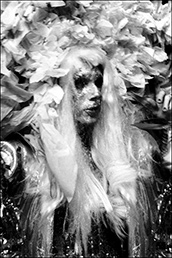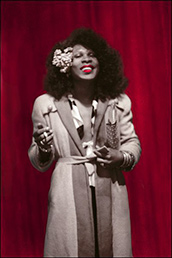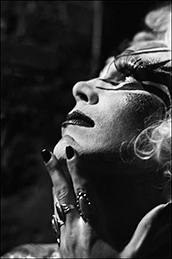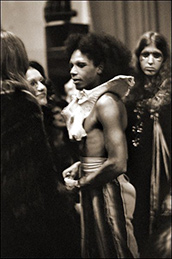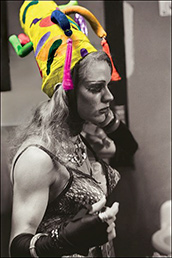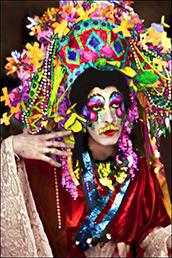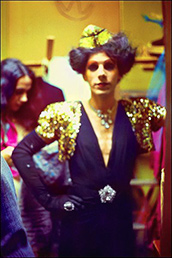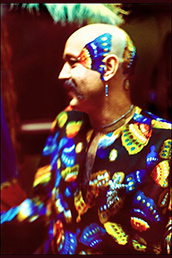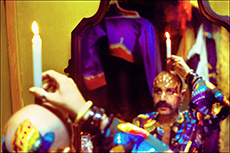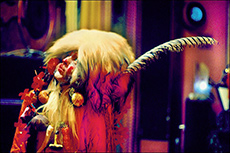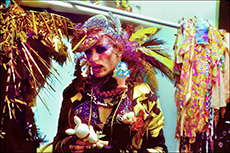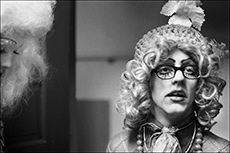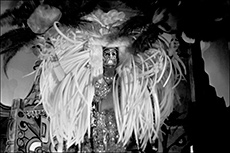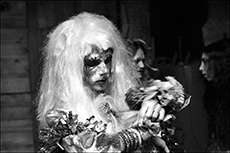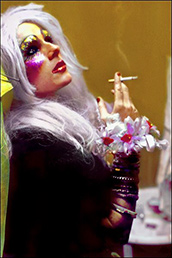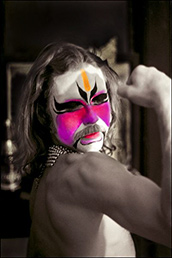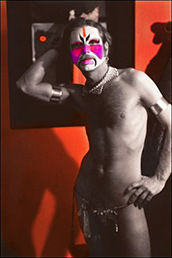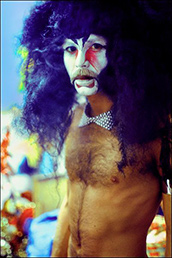|
|
|
|
|
|
|
|
|
|
||||||||||||||||||
|
|
Return to the Photography Gallery | |||||||||||||||||||||||||
In Our FashionPhotographer Roger Arvid Anderson talking with clothing designer and textile artist In the late Sixties and Seventies young gay men moved from all over America to San Francisco as an act of sexual liberation, which was considered then to be a defiant if not deviant form of personal reinvention. The Cockettes were different by being no different. Divine had already made a movie with John Waters before moving to San Francisco. Only he kept it a secret from his wealthy parents in Baltimore. Sylvester on the other hand was raised by his mother and shared a bunk bed with his brother in a tiny two-room house in Los Angeles. Nevertheless, he had been a child gospel star. Hibiscus came from a family with a theatrical background. He founded his own children's theater troupe in Florida and as a teenager in New York appeared on television and the Off Broadway stage. Tahara's father was a rodeo clown in a town not far from Wichita Falls, Texas where Billy Bowers was born on September 19, 1947. As a clothing designer, where does it all start? "Anyone might think my life has been one costume party after another, but that's just not true. Certainly not as a child. I was never into dress up, if anything dress down, because it was always so damn hot." Did your mother sew? "No way. I can honestly say I never once saw my mother thread a needle. Her name was Wynell Gertie Bailey. She was lucky number 12 from a family of thirteen kids in Thornbury, Texas, which is nothing more than a gas station, a school and a Coca Cola machine. She was only a teenager when she met my Daddy who was a good twenty years older than she was. Lucky she said, because she saw that blue Mercury pull up, she watched the door swing open, he smiled, she got in and left. Not that Wichita Falls had much more to offer." What does Wichita Falls have to offer? "Nothing. It's in the middle of nowhere. I'm talking about a long, lonesome stretch of Route 66 at the base of the Texas panhandle. If you had it in mind to spit you could hit Oklahoma. What put the city on the map back then was Sheppard's Field. In the 1950's it had to be the largest Air Force training base in the country." Can you tell me anything about your father? "Not much to tell. He died in 1950 when he was 58. I was three years old. I later heard he had some oil wells because my mother sold them and bought a bar called the Zoo, as well as a brand new Pontiac Bonneville. She moved me, and my two older brothers to a track house near the Hirschi High School, so we could be in a better part of town." How would you describe mother? "She was what they used to call a loose woman. She ratted her hair and ran around with two barmaids called Lois and Patsy. She thought nothing of dancing till dawn. It didn't take her long to go through two more husbands. Then after losing the bar she worked for 15 years in the liquor department at Walgreen's. To pad the day she'd sell shots of whiskey on the side and kept her tips tucked between her boobs inside her blouse. Every time she gave me movie money the bills were moist. But I can't complain since there was nothing else to do. I saw as many as three movies a day including the newsreels. Wichita Falls back then was very much like that dust bowl town in Peter Bogdanovich's film, The Last Picture Show." What did you do in high school? "I was a cheerleader and I was a member of the annual yearbook staff." How did the other kids treat you? "When I started wearing bell-bottoms people started calling me queer. Once during a football rally I heard the women's gym coach sniff that I probably had ruffles on my underwear. Still, I can't say anyone ever beat me up and I guess I was likeable enough because I was selected by popular vote to be a cheerleader. I also double-dated with a really good-looking football player. We'd get drunk, finger-fuck our girlfriends, then go home and dry hump under the sheets. The next day we'd never talk about it. I mean, it was Texas: it was flat and hot and the Bible Belt. The swimming pool had a floating line with one side for girls and one side for boys. Dancing too close at any school parties was out-and-out illegal." What choice did that leave you? "For a boy in Wichita Falls you had one of two futures, either a shotgun wedding or getting out of town. It was weighing on my mind. I know because as I was closing in on graduation I started listening to rock music. I got 'turned on' by this garage group called The Seeds, and I just knew I had to go to L.A. It was either that or pulling vegetables and raising children in Wichita Falls." Did you talk it over with your mother? "She was looking to move too. She looked south to Dallas and I looked west." When was that? "The summer of 1966. I walked around the local junior college for about ten seconds, and decided that wasn't for me. After that my girlfriend Sharon Zelina and I threw our bags into the back of a Dodge Dart and high-tailed out of there. The car belonged to her sister and she did the driving. They were both Air Force brats. After a month in Los Angeles the girls got wise to my hormones and moved on. I took a room on Sunset Boulevard. I worked briefly at a discount store where the manager took me to his apartment so I could have my first LSD experience. Once I got high he got into my pants and I freaked out. I told you in Texas you do it but don't talk about it. When I left I was still hallucinating. Walking down Sunset I wasn't sure if the cars were slowing down because they thought I was a hustler, or whether this was what they meant by a head-trip. Whatever it was I never looked back." Did you go back to the discount store? "No. I got a job at Lenny's Boot Parlor at Gower and Sunset. It's next door to Paramount Studios. The store specialized in ultra men's wear. Celebrities would stop by to look at clothes and chat. I got to meet The Monkees, Jose Feliciano, Sally Fields, and a bunch of other TV stars. Sometimes I had to deliver clothes on the set, which is how I got nabbed for a spot on the Dating Game in 1967." What happened? "I lost. I didn't get picked." Did that bother you? "Are you kidding? I was already running around with this drop-dead gorgeous chick. She was known as Miss Connie and she was a GTO, which is shorthand for Girls Together Outrageously. Frank Zappa was their backer and they had some pretensions to being singers. I think they released one album called Permanent Damage. That sounds about right. I remember there was Miss Mercy and Miss Christine, also Miss Lucy who was Frank's nanny, which is how I got invited to the Zappa compound in Laurel Canyon. We'd all go out to visit her. Then I started living with Miss Connie. It didn't take long to figure out she was not your standard street corner whore. All she'd wear at night were some stockings and three layers of lavender panties covered by a big lynx coat. Cars would go by and she'd flash her assets. Whenever she was going out she'd wink at me, 'Honey, I'm going to the bank!'" Were you into the club scene? "Like all the time! By day I'd work at Lenny's and at night I'd go to this club called Whiskey a Go-Go. In those days dancing was illegal in a bar, but the club had an elevated stage where fifty freaks were allowed to dance for what they called atmosphere. Basically I became a BTO, Boys Together Outrageously. We, and the girls were given free burgers and cokes, also access to the upstairs dressing rooms. That's where you got your drugs and lost your inhibitions. It was popular with the 'in crowd'. Look, the girls were all beautiful and available, and we were like their male escorts. I especially remember this one guy who wore a lot of mascara and blue eye shadow. I was so naïve then I didn't know it was Tony Curtis. Lots of film people went there. I got to meet Paul Winfield who was the star of the film Sounder, also Johnny Weissmuller, you know, Tarzan. I even got to meet Nat King Cole." Where else did you hang out? "Sometimes I'd crash at The Farm on Santa Monica Boulevard. It was the first gay discotheque in West Hollywood. That's where I met Sylvester, and Goldie Glitters, when he was still known as Michael. Reggie was also a BTO, but he went to The Farm too. Later they all became Cockettes."
Anyone else? "Who became a Cockette? Yes. There was this hip nightclub called The Troubadour. Lots of performers got their start there. I remember August 25, 1970. It was the night Neil Diamond first introduced Elton John to the American public. Of course, I didn't know who the hell Elton John was, but I did meet this lanky blonde in the audience." Who was that? "Wally Walden could charm the pants off of anyone, and he did. We immediately started hanging out together. Right away we got busted hitchhiking, which was illegal then. Actually I was so stoned I fell off the curb. Then Wally and I got busted again and were taken to the Hollywood jail. Wally's father was this big-shot lawyer in Minneapolis and after a phone call we were let out. In a matter of days we moved to San Francisco." When was that? "Around my birthday. That would be the middle of September in 1970. Wally found his own place and I took a room in North Beach above the Condor Club at Broadway and Grant. I didn't know how famous it was as a strip club until I looked up and saw this giant sign: a two story naked woman. It was hard to sleep at night because the red lights in Carol Doda's neon titties kept flashing in my room. Luckily I got myself another day job in the rag business right in the neighborhood, at a place called Middle Earth Clothiers on Upper Grant. Across the street was a bar called The Capri. One of the bartenders there had a shaved head and liked to be called Mavis. Soon I learned he was also a Cockette on the weekends. He had this group of 15 or 20 people who would leave the bar together and walk to the Palace Theater. That's where the Cockettes performed between the midnight movies. It was only a few blocks away in Washington Square. He invited me to join them and I did. The rest is history." How so? "First, I bump into Reggie from L.A., only now he's living in San Francisco, and he's a Cockette. Then Wally told me he had joined the Cockettes. Then at one of the shows someone introduced me to Scrumbly, who had to be the closest thing to a director the Cockettes ever had. Anyway, he took me home that night. We had a brief fling. That's how I met everybody. At that time anyone who wanted to help could join the Cockettes." And? "It didn't take long for me to give up my room and move in with Reggie. He was living at a commune on 15th and Noe. So I'd go with him to rehearsals. That's when I started helping John Flowers build and paint the sets. I also sang in the chorus, but I especially liked to watch Nikki Nichols make costumes. I guess you could say he became my mentor."
Is that when you first started making clothes? "No, I actually started making clothes when I was living with Miss Connie in Los Angeles. Since I was already selling clothes, I found I had a feel for what looked good. I had an eye for details. I just needed to learn how to sew. Miss Connie taught me how to make accessories, such as shoulder bags, chokers and hats, which I sold to James Reva for his upscale clients in Beverly Hills. When I moved to San Francisco I wanted to keep on making clothes. Nikki then inspired me to develop my own style. I soon found I had a knack for assemblage, but that came with the territory. The Cockettes were all about dripping in bracelets. They loved obsessive layers of vintage baubles and showy geegaws. They couldn't wait to hit the used clothing stores and find stylish dresses from the Deco era. They were really the first to introduce thrift store chic." Where did that lead you? "I had been with the Cockettes for nearly a year when it was announced that they were going to New York. I thought about the November debut date and realized that I had just enough lead-time to create my first real line of customized clothing. Things I could bring with on the trip. After working like a dog I decided to hit Los Angeles first for a few days and test the waters. Holly Harp put a few of my jackets in her store window. She was across the street from the offices of Gibson and Stromberg, the PR firm that handled the Rolling Stones. The boys happened to be in town and saw the jackets from their car window. They called Holly and asked her to have me bring them up to their house in the Hollywood Hills." Go on. "All the Rolling Stones were there. Right away Mick Jagger made it clear he never spent more than a hundred dollars on anything. So I showed him a coat I had made out of an old bedspread from the Fifties. I called it the Sailboat Coat because it was decorated with little baby-blue yachts. I gave it some texture by sewing on scores of tiny seashells. Keith Richards was the one who wanted to try on everything. He spent $250 on a silk jacket with a big dragon on the back of it. I made it from some remnants left over from the costume trunk that the Peking Opera left behind after they had played the Palace. I'm not so sure it was lost, but as far as I'm concerned that was sequin heaven and I got my first taste of the exotic. After that, I cut up a Moroccan caftan into a pair of pants. Keith Richards bought those. Mick Taylor, another guitarist, and Nicky Hopkins, the pianist, also bought some of my flash jackets for their upcoming American tour." Which tour was that? "The Rolling Stones 1972 American Tour. It was one crazy thing after another. Then whoever thought Mick Jagger with those big rubber lips of his would become a sex symbol? But that was the beginning of glam rock and all that." All that what? "You know." Androgyny? "That's it. Just don't ask me to spell it." Anything else? "All that on stage and off stage drama. Everyone's a star. Everyone needs their ego massage. The Palace got glam going before London and New York had their fingers to the wind." What happened to those jackets? "Who knows? If Keith Richards can heave a TV set out a window ten stories up, you can only imagine the state of his wardrobe. But I can't complain. I made enough money to fly straight from L.A. to Kennedy Airport in New York. I packed at least ten outfits into my luggage and arrived just in time for the opening night at Anderson Theater. I sat in the balcony with Ford Wheeler and Zomba. They both were into underground theater. Zomba I knew from San Francisco. He was now living in a loft with an artist by the name of Ken Tisa who was into beading. Ken took one look at my stuff and told me to pile more on. More badges! More plastic doodads! It was Ken who introduced me to the junk shops of Canal Street and the button shops of the Garment District. Since then no one has ever accused me of 'less is more'." So you weren't on stage for the debut? "No, and it proved to be a disaster. I think New York audiences were expecting Showboat and not Tin Pan Alley. Of course I was broke again and needed to sell some of my gear. So I stayed on when the rest left. I managed to retrieve a hat and two feather jackets that I had made for John Rothermel in the role of Petrushka. I sold them to Norma Kamali who was working out of a basement shop on East 53rd Street. That's before she made it big with her parachute collection, which was cut from army surplus silk. But you get the idea, we all liked to work with eccentric materials. I really liked to recycle fabrics from one era and then reassemble them as patchwork jackets and tunics with ornamental accessories. In some ways these new manifestations were really three-dimensional sculptures. I'd add so many appliqués like miniature fruit or bakelite brooches that eventually my clothes were easier to stand up than fold up. I was told that I should be signing them. I probably should have. Right away Norma asked me to make some more hats and sent me to a feather factory in Montreal." Who else did you meet? "Ken Tisa also introduced me to Barbara Brown. She had a vintage clothing store on Newbury Street in Boston called The Caprice. After I finished all those hats for Norma, Barbara had me come to Boston to make clothes for her. She lived in a gigantic house in the blue hills just outside the city. Her husband was some kind of politician. Barbara was really crazy. But she was from old money and she had the gift of gab. I stayed in what she called the slave quarters. Her biggest clients were Aerosmith. They weren't all that famous yet and when we went over to visit them they were still sleeping on mattresses. I attended some of their concerts and then designed outfits for all of them like Steve Tyler, who was the lead singer and guitarist Joe Perry. Barbara also got me into another boutique in New York called Granny Takes a Trip. That's how Alice Cooper and Led Zeppelin discovered my clothes because the shop catered to rock stars. Barbara then got me a fashion shoot with an industry professional at Andy Warhol's silver factory. It was called that because everything was covered with tinfoil." That session was featured over a year later as a six page spread in the Feb/Mar 1973 Italian issue of L'Uomo Vogue. Billy's last project in the East, for Bonwit Teller, was a series of thirty Dance Macabre Dresses done in the wrap-around style. They were created from squares of linen that he threw over colonial era tombstones and rubbed with black chalk. Later the chalk was sealed into the linen by running a hot iron over wax paper. Do you remember which cemetery you visited for the rubbings? "I sure do. It was under a lot of snow, but it was right in the middle of old Boston on Tremont Street by the Park Street Church. It was called the Granary Burying Ground and had this Egyptian Revival gate. I was looking for gloomy and did I get it. The slate tombstones had these wild sculptural reliefs: primitive skeletons with scythes, and skulls with wings that anyone would think were angels of death. I nearly froze my ass off." Was that enough winter? "Three months was more than enough!" By the spring of 1972 Billy was back in San Francisco and joined his protégés for yet another version of Pearls Over Shanghai. The first had been in November of 1970. So you were in the first version as well? "Yes. I was a last-minute substitute for Reggie in the first version because he had to go to some family event in Los Angeles. I performed the role of Chop Chop, and then in May they asked me if I'd do it again. Like everyone else I designed and made my own costume. I wore a fake fur handbag as my hat and used the handle as a chinstrap. My beard was made of black and white monkey fur while my cuffs and collar were patched from Chinese antelope. And like everyone else I had bracelets up to my elbows. Of course it's nuts, me playing a Chinese villain with a southern accent."
Who else did you pal around with in these photographs? "Wally, of course. He and Prissy were always hitting the Flower Market at six in the morning when they threw out the leftovers from the day before. Wally liked to wear orchids on his wrist or a halo of dahlias. If anyone taught me excess it was Wally. He always designed the most flamboyant headgear. One had so many long strips of bouncing white Styrofoam you could barely see his face. And then there was David Venice. He was just the opposite. He painted his face up Chinese Opera style for Pearls; otherwise he was nearly naked. Everyone else wore as much costume as they could possibly carry, including myself. David and I ended up bar buddies for the summer. We made rent by selling hog in the Castro. That's what they used to call Angel Dust. We were so bad."
And then it really was over? "That's right. Vice Palace was the last show. I was in the audience for that one." Any historical assessments? "The Cockettes were about freedom, and in our fashion it was a very liberating experience. For a clothes horse like myself that meant the freedom to use anything and everything. As a group we gravitated towards color, plus gobs of glitter." Was it a creative high? "High, low, we did it all. Look, I'm a hick from the sticks who got lucky." What do you mean by lucky? "My mother was lucky to get out of Thornbury. I was lucky to get out of Wichita Falls. The only vegetables I'm pulling are itty-bitty plastic tomatoes. I'll use them on one of my Parody Jackets, maybe add a bunch of little rubber frogs." Would you call yourself a collage artist? "Why not, but there's a method to my madness." Tell me about it. "For instance, if I use a fabric from the Fifties, then I will try and find some trifles and trinkets from the Fifties. I just don't use anything that I come across; things have to correspond in some way. I made a Cowgirl Skirt once out of a sweet piece of leather chamois. First I garnished the hem with some big buttons, and then I took a toy gun-belt and stitched it around the waist, except I got rid of the guns in the holsters and replaced them with stuffed animals. Where the bullets were I put some miniature bean pots. I guess it's got a message. Bianca Jagger bought that one." I see you like to use paper as well as cloth and plastic. "I collect press clippings, goofy old photos and decals. I tore up a book of fairy tales once and used the illustrated pages to make a Fantasy Coat." Any memorable commissions? "The Bat Cape. Alice Cooper was the avatar of shock rock. So I knew it had to be a scream. I used white leather as a base fabric and covered it with stuffed albino rats with ruby eyes. Each of the rats had in its mouth the wing of a black-lacquered bat. I wired the collar so it would stand upright, and then added a matching hat. It was so mad and so over the top Alice never wore it on stage. I'm told he never got the chance. Apparently Salvador Dali was painting his portrait and got so entranced by all my rats and bats that he took it. Since he's the master of the surreal I suppose it's some sort of compliment. I heard he was seen in New York parading it around." What about poor Alice? "Funny you say that. He gave me another commission for a Dollar Bill Coat. He wanted to wear it to a charity event thrown by Rose Kennedy. I used real dollar-bills: 150 of them. Alice kept the coat and according to the columnist Liz Smith, didn't give the charity a penny." Tell me more! "Let's see. There's my Auto-sex Coat. That's a gold kid leather job with a sexy photo of Peter Berlin on the back, and a cut-up poster of Divine from Pink Flamingos on the front holding a pistol, and on the other side a photo of Helmut Berger from The Damned. For my Sin City Coat I thought black lizard skin sounded sufficiently decadent. Then as an afterthought I added at the bottom a little gold flap for you know what." What? "Easy access." You are bad. Halloween comes once a year but in San Francisco it's every day. Billy Bowers is living proof and a living legend. L'Uomo Vogue, Playboy, After Dark, City Magazine, Market Street, Eighteenth and Castro. Anyway you look at it, he's still threading needles and pushing buttons. Not bad for a kid from Wichita Falls with ruffles on his underwear.
|
||||||||||||||||||||||||||
Images and Text © 2012 Roger Arvid Anderson, All Rights Reserved |
||||||||||||||||||||||||||
